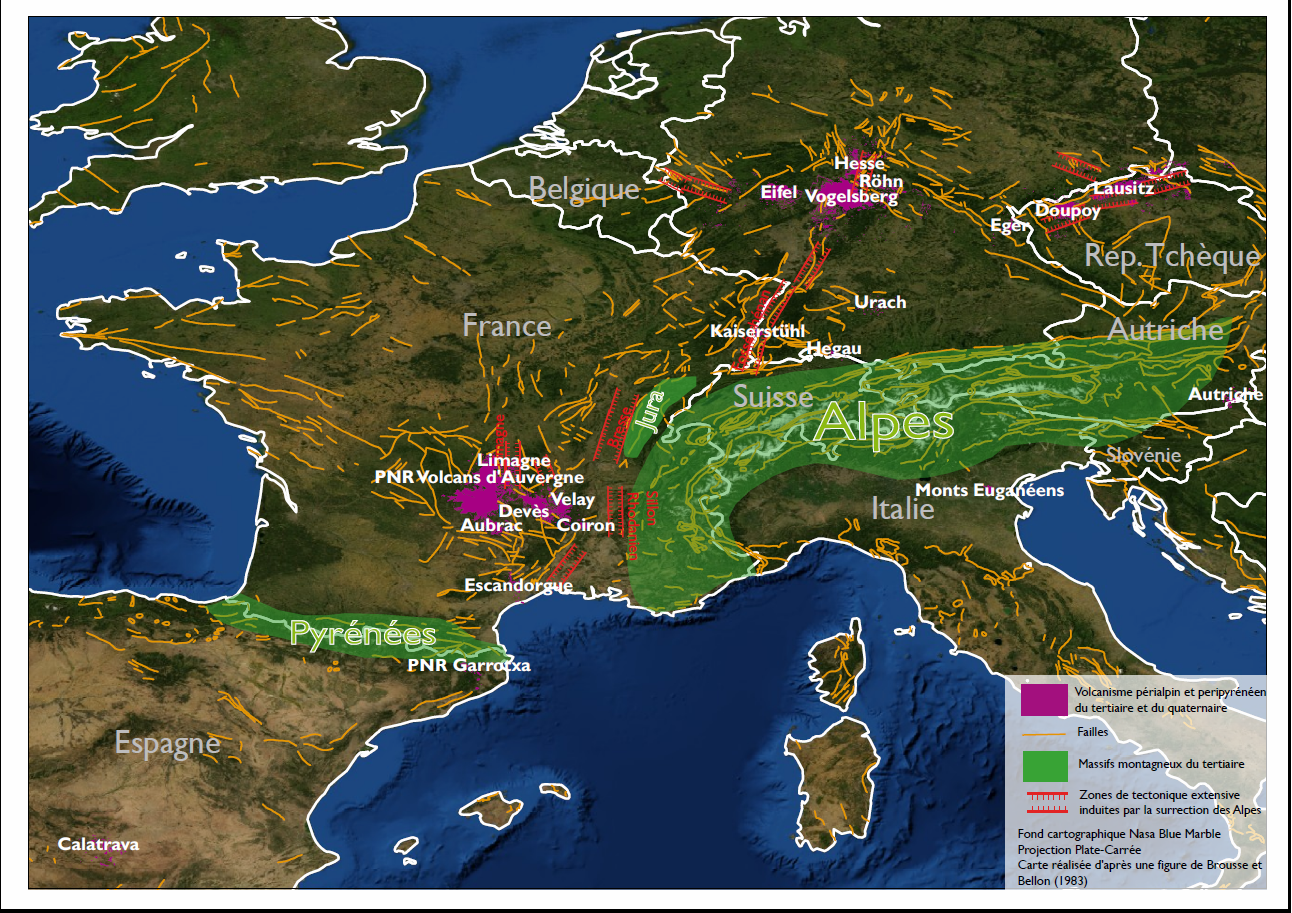Actualité volcanique, Articles de fond sur étude de volcan, tectonique, récits et photos de voyage
Par Bernard Duyck
The Vogelsberg volcanic massif is located in the Rhine graben, a plain 35 km wide on average x 300 km. length, between Basel in the south and Frankfurt to the north.
The Rhine Graben forms the central segment of the European Cenozoic rift system that stretches over 1,000 km from the Mediterranean to the North Sea.
The opening of the Rhine graben began during the Tertiary (there are about 33 million years ago), at the beginning of the Oligocene. The gap formed is quickly invaded by the sea, first in conjunction with Alpine Ocean. It is deposited sediment in particular economic interest: sodium salts and potassium, also marl and sandstone where oil has accumulated (deposit Pechelbronn). The gap then opens into the North Sea. Then a regional tilting due to the uplift of the Alps causes the retreat of the sea and only freshwater lakes remain.
The Rhine Valley has all the geological characteristics of a continental rift:
- The Rhine Valley is located in intra-plate area.
- The presence of an axial sedimentary plain where sedimentation was very important.
- Curbs structured in "tilted blocks" by playing normal faults. This reflects a tectonic extension. The presence of these faults, mostly inactive, explains the existing residual seismicity in this area.
- An important volcanism but of alkaline type : there is no ocean floor that was put in place.
- A rise in the Moho at the origin of the crustal thinning and the birth of magmas.
Volcanic fields in central-western Europe: in the vicinity of Frankfurt, the Vogelsberg and Rhön - Eifel is referred WEVF (West Eifel volcanic field) HEVF (Hocheifel VF) EEVF (East Eifel VF) - map in "Volcanism" / H.U.Schmincke.
The peri-alpine alkaline volcanism produced in Germany the massive of Eifel, Vogelsberg and Rhön. The last two massive are dated from 20 to 14 Ma, a short time, geologically. (18-10 Ma Vogelsberg - pic 17-15 Ma)
Magmas issued have a composition ranging from basanite to quartz tholeiitic; from trace elements and isotopic composition of Nd, Sr and Pb, we deduce three different mantle sources:
- A source of a typical asthenospheric plume enriched in trace elements, the composition similar to that of European asthenospheric tank in connection with the tertiary volcanic level.
- A depleted mantle source, located in the upper lithospheric mantle or the asthenosphere,
- A veined mantle source (marbled).
This suggests three stages of training:
1. Mixtures melt from the mantle back to the magma chamber and moving towards eruptions characterized by differentiated lavas.
2. Molten rocks from a depleted mantle source, and a progressive mixing with asthenospheric source.
3. After exhaustion of depleted mantle source, the molten rock are coming from an asthenospheric source.
... a shift towards sources less profound.
To the left, the Rhine Graben - doc.CNRS / C.Brunet - Jolivet & Nataf - to the right, ECVP (European Cenozoic Volcanic Province) subareas Vogelsberg - Age data from Abratis et al. - Click to enlarge.
Location and assumed mechanism of implementation :
Areas of volcanism are located perpendicular to the rift system of the upper Rhine valley, oriented NNE-SSW.
The lithosphere has a uniform average thickness of 100 to 140 km. in the Western Europe and Central Europe. In contrast, this thickness is only 60 km. in the Rhenish Massif, in relation to the former Variscan welds. Crustal lithosphere has a thickness less than 30 km. under the Vogelsberg and is penetrated by numerous dykes at a depth of 20 km (Braun & Berckhemer 1993)
An uprising of the asthenosphere-lithosphere boundary could have been caused by a local thinning of the ductile lower crust under extension resulting from the subduction of the Alpine lower crust.
The peri-Alpine Tertiary volcanism (purple) - extensive areas of tectonic uplift induced by the Alps (shaded red) - Doc. by Bellon & Brousse / Aurelienb
Geodynamic model proposed for the origin of the ECVP - Alpine subduction thinner crust at the welds Variques in the pre-Alps. Thinning allows asthenospheric ascent and movement of small-scale convection in the Rhine graben - doc. in "The European Cenozoic Volcanic Province is not Caused by mantle plumes" / by R.Meyer & G.Foulger
Sources :
- Eduterre : Un rift continental, le fossé Rhénan - link
- CNRS - Le fossé Rhénan, un océan avorté - link
- Petrogenesis of basanitic to tholeiitic volcanic rocks from the Miocene Vogelsberg, Central Germany - by P.J.F. Bogaard & G. Wörner / Journal of Petrology.
- Petrogenesis of tertiary continental intra-plate lavas from the Westerwald region, Germany / Journal of Petrology.
- The European Cenozoic Volcanic Province is not caused by mantle plumes / by R.Meyer & G.Foulger
- Der Vogelsberg - Geotope im grössten vulkangebiet mitteleuropas - Th. Reischmann & Ad. Schraft.
Thème Magazine - Hébergé par Overblog


/image%2F0935525%2F20140610%2Fob_23011b_fosse-rhenan-graben-du-rhin-cnr.jpg)
/image%2F0935525%2F20140610%2Fob_9a7989_ecvp-subareas-vogelsberg-age-data-fr.gif)



